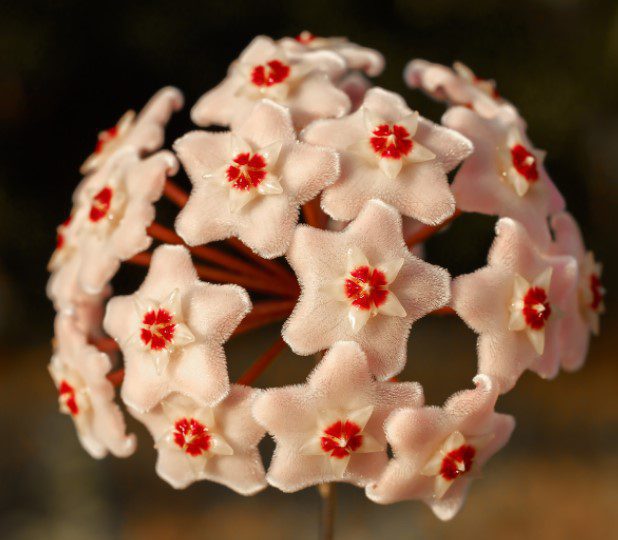Hoya Carnosa
Popularly known as the wax plant (Hoya carnosa, Heb. Batsheva) or the porcelain flower the hoya has an artificial look. Easy and undemanding by nature, hoyas will grow in most situations except in the full sun.
The fragrance from a blooming hoya is most noticeable after dark and can easily fill a large room. They are sweetly scented, if the scent becomes overpowering, the plant can be stood outside during its flowering period.
Hoyas are long-lasting and will grow for years without much attention other than occasional watering.
But a regular feeding program is necessary to make the plant bloom continually.
The Hoya carnosa can be described as a lovely climbing house plant that twines and twists with exotic star-shaped pink flowers with a white hue.
In June, bunches of around 10 to 20 wax-like flowers appear and continue in bloom for two to three months.
People seeing the wax-like hoya carnosa blossoms for the first time feel the need to touch them to see if they are real.
Native to eastern Asia and Australia, and India, hoya carnosa were named after Thomas Hoy, gardener to the Duke of Northumberland on his estate of Syon House in Northumberland, England, at the end of the 18th century. His employer was an enthusiastic collector of rare tropical plants.
Although hoya carnosa is a genus comprising around 200 different species, only two species are available in cultivation – the Tasmanian Hoya carnosa or the slightly more delicate Hoya Bella, originating in India.
Hoya Sulawesi
Hoya sulawesiana is similar to Hoya isabelchanae Rodda & Simonsson in flower morphology because both species have pubescent globose corolla. Still, they can be separated based on leaf morphology and corolla indumentum type.
Hoya surisana is very unusual because its flowers display a combination of large calyx lobes, a creamy white, pubescent, campanulate corolla, and dark purple corona lobes so far not observed in any other species of the genus.
HOYAS ARE Plants That Do Better When Left Alone
They resent being overwatered, repotted, and pruned hard. This is because the flowering hoya clusters are produced on the same short stems every year. Therefore the flowering spurs must be left in place after flowering is completed.
The vine produces its new growth first as long shoots completely bare of leaves, growing up to two meters long.
Be careful not to cut these shoots off. Once the shoots are fully elongated, this new portion of the vine produces pairs of fleshy leaves along the stem.
This growing habit is a throwback to the plant’s native habitat in the wild, where it extends its new growth long distances through the branches of trees and shrubs, all before becoming weighed down with heavy leaves.
North Sulawesi is one of the regions comprising the Wallacea bioregion, the world’s source of biological diversity, and a hotspot of endemism. The greatest threat to a variety of Wallacea endemic species is forest fragmentation and population growth.
two new species of Hoya from Sulawesi, Indonesia, H. sulawesiana S.Rahayu & Rodda and Hoya surisana Rodda & S.Rahayu.
Position:
Full light with protection from strong sunshine, which can mark the leaves. Although hoyas grow well in shady positions, they do even better in bright indirect light. Insufficient light causes dark-green leaves and few or no flowers. Place them in hanging baskets and you should be good to go.
Temperature:
Minimum winter temperature of 10, but hoyas can tolerate down to 7. If the temperature drops lower, it can kill off a lot of the top growth, which will need a year or two to restore.
Watering:
Do not overwater. Let the soil dry out between waterings. In winter, keep on the dry side; watering every other week is sufficient in summer increase to once a week.
Overwatering turns the leaves light and limp. If this occurs, let the plant dry out before giving it any further water, and it may pick up.
Humidity:
Hoyas enjoy high humidity together with plenty of fresh air.
Soil:
Hoya carnosa needs good drainage and grows best in a mixture of peat moss, soil, and volcanic rock.
General care
Hoyas are considered easy to care for. Keep the leaves free of dust. Like all other houseplants, dust buildup on the leaves cuts down on the amount of light by up to 60%. Wipe over with a moist cloth if the leaves are very dusty.
Hoyas enjoy being sprayed with clear water once or twice a month. A sign of underwatering is when the leaves start to pucker inwards. Full recovery takes place once the plant is watered.
Repotting:
Growing in the same pot for years does not seem to bother hoyas. The plants flower better if pot-bound. If the plant becomes top-heavy, transfer to a pot one size larger. Make sure there is support for the vine to grow around.
Pruning:
Unnecessary unless the plant needs shaping. Hoyas generally dislike being cut back, so restrict to removing dead leaves and shoots only.
Propagation:
From May until August, take stem cuttings 5-10 cm long of young shoots. Place in equal parts peat moss and sand and root at a temperature of 16-20.
Pest and diseases:
Can attract aphids during early summer. Spray with an insecticide or soapy water. Leaves turning brown is a sign of too much water.
Tip of the week
If you are going away for a few days, don’t leave houseplants in the window; they will dry out quickly. Move them to the middle of the room, where there is some light.
Give them a good watering and leave just a little water in the saucer.
Depend on the pot’s capacity, this should stop your plants from drying out for seven to 10 days.


























